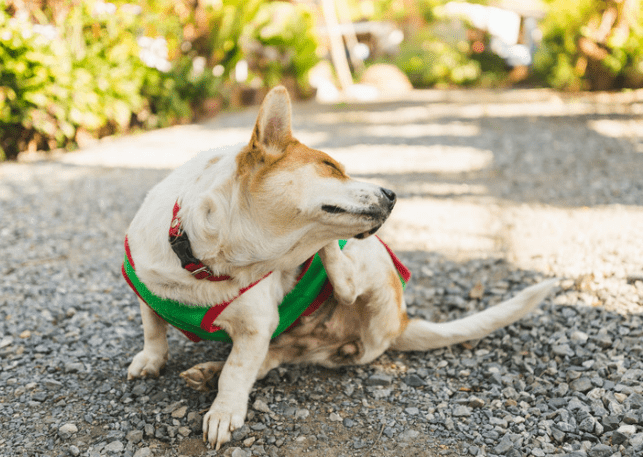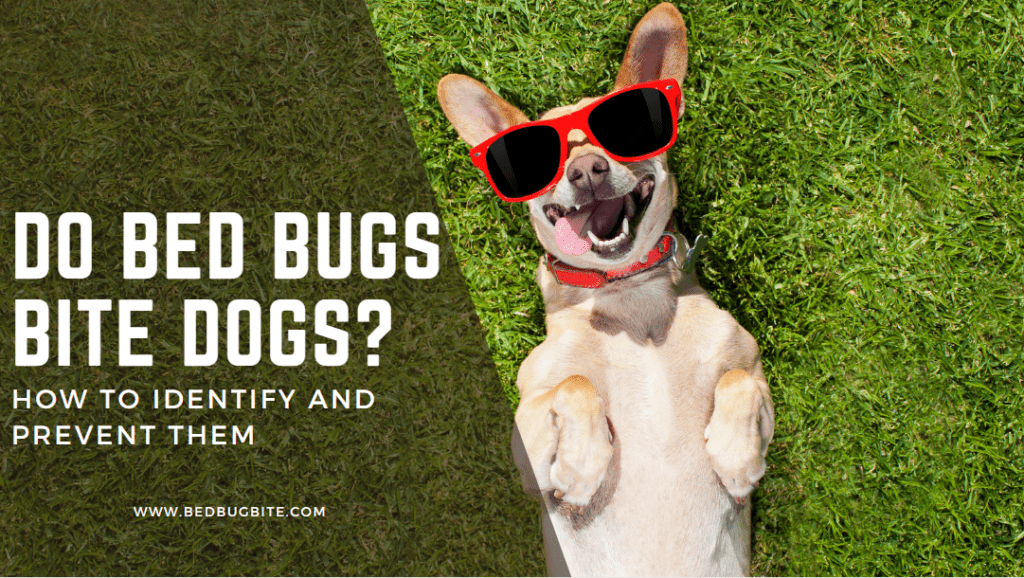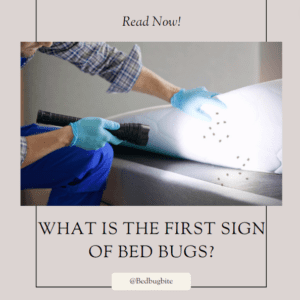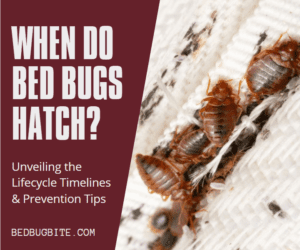Introduction

Your furry friend’s comfort and well-being are of utmost importance to you, and nothing can be more distressing than the thought of bed bugs taking a bite out of your beloved canine companion. While it’s relatively uncommon for bed bugs to target dogs, it’s not impossible, and understanding the signs and distinguishing them from flea bites is crucial. In this blog post, we’ll explore the rare scenario of bed bug bites on dogs, how to identify them, and what steps you can take to prevent these tiny intruders from causing discomfort to your pet.
Bed Bug Bites on Dogs
Bed bugs, scientifically known as Cimex lectularius, are tiny, blood-feeding insects notorious for their preference for human hosts. However, these opportunistic pests can adapt when circumstances demand it. In cases of a heavy infestation or when their human host is unavailable, bed bugs may resort to biting other warm-blooded animals, including our four-legged companions—dogs.
Bed bug bites on dogs often mimic their appearance on humans, making them particularly challenging to detect. These bites manifest as small, red, itchy welts that can easily be mistaken for other skin conditions. They are characterized by their tiny, round shape and are typically found in clusters or linear patterns on areas of your dog’s body that are exposed while they sleep. Common locations for these bed bug bites include the belly, ears, and nose.
The resemblance between bed bug bites on dogs and those on humans is uncanny, further emphasizing the need for vigilance when it comes to identifying these pests. While bed bugs typically prefer human hosts due to our higher body temperature and the carbon dioxide we emit during respiration, they can adapt when their primary source of nourishment becomes scarce.
These adaptable creatures can hitch a ride on your dog’s fur or bedding, seeking a blood meal during the night. Since dogs cannot communicate their discomfort as clearly as humans, it’s essential for pet owners to stay observant and take prompt action if they suspect their canine companion may be suffering from bed bug bites.
In the following sections, we will delve deeper into the nuances of distinguishing bed bug bites from flea bites on dogs and explore effective prevention and treatment strategies to ensure your furry friend remains comfortable and free from the irritation caused by these stealthy pests.
How to Tell Bed Bug Bites from Flea Bites
Bed bug bites and flea bites on dogs can be challenging to differentiate, as they share some similarities. Both can cause red, itchy bumps on the skin. However, there are key differences that can help you distinguish between the two:

Bite Pattern:
Bed bug bites on dogs often display a distinctive pattern that sets them apart from flea bites. These tiny, reddish welts tend to appear in clusters or linear formations. It’s as if they follow a path or a series of bites in a straight line. In contrast, flea bites on dogs are more haphazard in their arrangement, appearing as random and scattered red bumps on the skin. Observing the bite pattern can provide a valuable clue in distinguishing between these two types of bites.
Location:
The locations where bed bug bites and flea bites manifest on your dog’s body can also provide important insights. Bed bug bites on dogs are commonly found on specific areas that are typically exposed while your pet is sleeping. These areas include the belly, ears, and nose, as bed bugs tend to bite where the skin is most accessible during rest. Flea bites, on the other hand, can occur virtually anywhere on your dog’s body. This difference in preferred biting sites can be instrumental in identifying the source of the irritation.
Bite Size:
Another distinguishing feature between bed bug bites and flea bites on dogs is the size and uniformity of the welts. Bed bug bites are generally smaller and tend to be more consistent in size across multiple bites. They often appear as tiny, round, or oval-shaped red bumps. In contrast, flea bites can vary in size, with some being larger and others smaller. Additionally, flea bites may exhibit a characteristic red halo around them, providing an extra clue when trying to differentiate between the two.
Behavior:
One of the most crucial factors in identifying the source of your dog’s discomfort is their behavior. Pay close attention to how your dog reacts to the bites. Flea bites are notorious for causing intense itching and irritation, leading to excessive scratching, biting, and licking of the affected areas. If you notice your dog obsessively tending to a particular spot on their body, it’s often a strong indicator of a flea infestation. Bed bug bites, on the other hand, may not elicit the same immediate and pronounced reaction from dogs. This difference in behavior can help you gauge the nature of the infestation.
Inspection:

Finally, conducting a thorough examination of your dog’s sleeping area and bedding can provide critical evidence. Look for telltale signs of bed bugs, such as tiny reddish-brown bugs themselves, their shed skins, feces (which resemble small black specks), and eggs. Finding any of these indicators in your dog’s sleeping environment can strongly suggest the presence of bed bugs. In contrast, fleas often leave behind their droppings, which resemble small dark, comma-shaped specks known as “flea dirt,” in your dog’s fur and bedding.
By paying attention to these key differences and taking a proactive approach to inspecting and caring for your dog, you can better identify the source of discomfort and provide prompt and appropriate treatment or preventive measures.
Preventing Bed Bug Bites on Dogs
Preventing bed bug bites on your dog starts with keeping your home bed bug-free. Here are some tips:
Regular Inspection:
Routinely inspecting your home for signs of bed bugs is a crucial step in preventing infestations that could lead to bed bug bites on your dog. This becomes especially important if you’ve recently traveled or had guests over. Bed bugs can easily hitch a ride on luggage or clothing, making their way into your home unnoticed. To conduct a thorough inspection:
- Check Your Dog’s Bedding: Start with your dog’s sleeping area. Examine their bedding, blankets, and pillows. Look for any unusual reddish-brown stains, small dark fecal spots, or tiny white eggs, which are characteristic signs of bed bug activity.
- Inspect Cracks in Walls and Furniture: Bed bugs are excellent at hiding in cracks and crevices. Inspect the seams, folds, and joints of furniture, including couches and chairs, as well as any cracks in walls and baseboards. Bed bugs often seek refuge in these concealed spaces during daylight hours.
Good Hygiene:
Maintaining proper hygiene for your dog and their belongings is essential in preventing bed bug infestations:
- Regularly Wash Bedding and Toys: Wash your dog’s bedding, blankets, and toys on a routine basis using hot water and a high-heat dryer setting. Bed bugs are sensitive to heat and washing helps eliminate any potential hiding spots for them.
- Grooming Tools: Don’t forget about grooming tools like brushes and combs. Bed bugs can hide in these as well. Clean and disinfect these tools regularly.
Consult a Veterinarian:
If you suspect that your dog may be suffering from bed bug bites or flea infestations, it’s vital to seek professional guidance from your veterinarian:
- Proper Diagnosis: Your veterinarian can examine your dog’s skin and assess the extent of the problem. They can differentiate between bed bug bites, flea bites, and other skin conditions, ensuring that your dog receives the appropriate treatment.
- Effective Treatment: Your vet can recommend safe and effective treatment options, such as topical treatments or medications to alleviate itching and discomfort caused by the bites.
Professional Pest Control:
If you discover evidence of bed bugs in your home, it’s essential to address the infestation promptly and effectively:
- Contact a Pest Control Professional: Reach out to a licensed pest control expert who specializes in bed bug eradication. Bed bugs are notoriously resilient, and attempting to eliminate them on your own may exacerbate the problem. Pest control professionals have the knowledge and tools necessary to eradicate bed bugs safely and thoroughly.
- Follow Professional Advice: Follow the advice and treatment recommendations provided by the pest control professional. This may include vacuuming, steam treatments, and potentially using insecticides in a safe and controlled manner.
Travel Precautions:
When traveling with your dog, taking precautions can help prevent bringing bed bugs back home:
- Inspect Accommodations: Before settling into a hotel room or other accommodations, conduct a thorough inspection. Look for signs of bed bugs on the mattress, bedding, furniture, and in cracks and crevices. If you find any evidence, request a different room or consider changing accommodations.
- Elevate Bedding: Avoid placing your dog’s bedding on the floor. Elevate their bedding off the ground to reduce the risk of bed bugs crawling onto it from the floor or nearby furniture.
By following these comprehensive strategies, you can proactively protect your dog and your home from the annoyance and potential health risks associated with bed bug infestations.
Summary
While bed bug bites on dogs are rare, they can occur. It’s essential to know how to identify these bites and differentiate them from flea bites.
By staying vigilant and taking preventive measures, you can ensure your furry friend remains happy, healthy, and free from these pesky intruders. Remember to consult your veterinarian for guidance on treating any skin issues your dog may experience. With proper care and attention, you can keep your dog safe from the discomfort of bed bug bites.
Resources:
American Kennel Club (AKC) – How to Tell if Your Dog Has Fleas or Bed Bugs
U.S. Environmental Protection Agency (EPA) – Bed Bugs: Get Them Out and Keep Them Out




